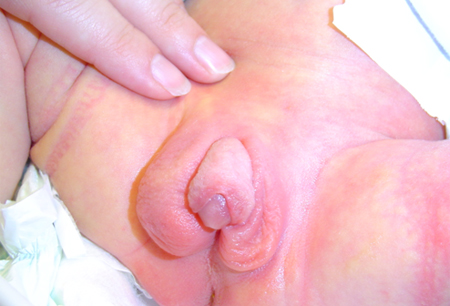Summary
Definition
History and exam
Key diagnostic factors
- atypical genitalia with no palpable gonads
- atypical genitalia with one palpable gonad
- atypical genitalia with bilaterally palpable gonads
- penile length <2.5 cm in a phenotypic male
- clitoris >1 cm in a phenotypic female
- hypospadias and undescended testes or separation of scrotal sacs
- urethral opening at base of phallus
Diagnostic investigations
1st investigations to order
- chromosome analysis (karyotype)
- serum electrolytes and glucose
- pelvic ultrasound
Investigations to consider
- serum 17 hydroxyprogesterone
- plasma renin activity
- serum 11 deoxycortisol and 11 deoxycorticosterone
- serum testosterone
- serum dihydrotestosterone
- serum LH and follicle-stimulating hormone (FSH)
- adrenocorticotropic hormone (ACTH) stimulation test
- human chorionic gonadotrophin (hCG) stimulation test
- anti-Müllerian hormone (AMH)
- urine steroid profile
Treatment algorithm
Contributors
Authors
Justin H Davies, MD, FRCPCH, MRCP
Consultant Paediatric Endocrinologist
Hon. Associate Professor
University of Southampton
Southampton
UK
Disclosures
JD is associate editor for the Journal of Paediatric Endocrinology and Metabolism; has travel bursaries from SANDOZ, Kwyo Kyrin, and Novo Nordisk; and has developed educational materials for Kwyo Kyrin. JD completed tenure as chair of the British Society for Paediatric Endocrinology in Nov 2020.
Acknowledgements
Dr Justin Davies would like to gratefully acknowledge Dr Gemma Watts and Dr Ingrid A. Holm, previous contributors to this topic. IAH and GW declare that they have no competing interests.
Peer reviewers
Paul Saenger, MD, MACE
Professor of Pediatrics
Department of Pediatrics (Endocrinology)
Montefiore Medical Center
Albert Einstein College of Medicine
New York
NY
Disclosures
PS declares that he has no competing interests.
Mary M. Lee, MD
Professor of Pediatrics and Cell Biology
Vice-Chair of Academic Affairs in Pediatrics
Pediatric Endocrine Division
UMass Medical School
Worcester
MA
Disclosures
MML declares that she has no competing interests.
Patricia Y. Fechner, MD
Associate Professor Pediatrics
Pediatric Endocrinology
University of WA
Medical Director of DSD Program
Seattle Children’s Hospital
Seattle
WA
Disclosures
PYF declares that she has no competing interests.
Use of this content is subject to our disclaimer
